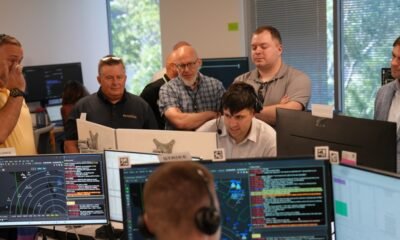Tools & Platforms
Lancom partners with Thread to drive AI & AWS innovation push

Lancom Technology has entered into a partnership with Thread to optimise AWS expenditure and implement artificial intelligence-driven solutions for managed services.
Thread, a provider of AI products aimed at streamlining managed service delivery, has chosen Lancom Technology as its AWS partner to support the scaling of its infrastructure and operations. In exchange, Lancom Technology will adopt Thread’s AI-driven offerings across its managed services division in a bid to enhance service delivery and foster further improvement.
Expansion efforts
The arrangement enables Thread to leverage Lancom Technology’s cloud expertise at a time when expanding in the United States market often presents significant hurdles due to the high volume of established managed service providers. Mark Alayev, Founder and Chief Executive Officer at Thread, said the agreement would support business growth for both companies.
Partnering with Lancom Technology allows us to scale our AWS infrastructure with confidence, knowing we have a trusted partner with deep cloud expertise,” said Mark Alayev, Thread Founder and CEO. “We’re equally excited to see Lancom adopt our technology to enhance their managed services, creating synergy that will drive innovation and growth for both companies.
Lancom Technology’s Chief Revenue Officer, Jahan Kahusi, described the partnership as a timely step addressing the dual challenges of managing cloud costs and making appropriate service selections within the complex AWS environment.
We are thrilled to partner with Thread as a forward-looking client looking to achieve more from every month’s AWS spend,” said Jahan Kahusi, Chief Revenue Officer at Lancom Technology. “Like many organizations, Thread recognizes that careful management of every aspect of its infrastructure reduces overhead, leaving more for investing in innovation and business growth.
Kahusi also emphasised the importance of not only controlling costs but also navigating the diversity of AWS services effectively.
Navigating the sheer extent of services available from AWS can be a challenge. As a trusted partner with a sharp focus bespoke consulting and delivery, our approach isn’t just about managing cost. It’s also about choosing the best tool for every job.
Cloud investments
The move demonstrates Lancom Technology’s goal of helping clients derive greater value from their investments in cloud infrastructure. Priscila Bernardes, Chief Executive Officer at Lancom Technology, stressed the importance of the partnership as recognition of the company’s ability to deliver secure and effective technology outcomes.
Thread has demonstrated its confidence in our ability to deliver scalable, secure, and efficient AWS solutions,” said Priscila Bernardes, CEO of Lancom Technology. “With our capabilities backed by AWS credentials, we’ll work with Thread to optimise cloud infrastructure to support its growth in the competitive U.S. market and beyond.
Thread’s engagement with Lancom Technology comes as both firms seek to serve a growing base of organisations pursuing digital-first strategies. Lancom Technology is part of Evergreen Services Group and maintains a track record of global delivery, including a presence in the United States. The company has been recognised with an AWS Cloud Innovation Award and supports over 600 clients.
Bernardes noted that, as an AWS Advanced Consulting Partner, Lancom Technology delivers specialist services globally via a ‘follow the sun’ model and brings to bear experience as both a managed service provider and software vendor.
Adopting AI
The relationship’s reciprocal nature will see Lancom Technology implement Thread’s AI solutions within its managed service operations in order to improve efficiency and the customer experience. Bernardes elaborated on the business rationale behind the move:
We’re constantly seeking opportunities for improvement and greater efficiencies, because that’s the name of the game in managed services just as it is in AWS infrastructure delivery,” Bernardes commented. “Thread has a proven offering and value proposal that we’ll be introducing for the benefit of our clients in sectors including financial services, healthcare, and professional services.
She also described the initiative as illustrative of Lancom Technology’s approach to suppliers and partners, crediting the firm’s recent business development in the United States to Kahusi’s network and industry reputation.
Securing Thread as both a client and a supplier is a credit to Jahan’s extensive networks and recognised ability as an AWS professional, paving the way for further growth and innovation.
Tools & Platforms
Vicky Demas on the value of easy to use imaging tools and the potential of AI

Photo owned by identifeye HEALTH and used with permission
identifeye HEALTH has launched its retinal screening platform. The platform is a compact, app-based system that is FDA-registered under a 510(k)-exempt classification. The company is initiating pilot programs with health systems and community-based providers.1
The system is designed for point-of-care environments, allowing nurses and medical assistants to capture high-quality retinal images with minimal training. The company has stated that the identifeye Camera can help to lower common barriers to screening, including time constraints, cost, and limited specialist availability.1 The goal is to help triage patients who need specialist care while reducing bottlenecks in the healthcare system.
With the announcement of this news, Modern Retina had the opportunity to speak with Vicky Demas, CEO of identifeye HEALTH to discuss how this advancement in technology can benefit patients and ophthalmologists. Demas is an engineer by training who has spent the last 25 years working at the conjunction of technology and healthcare.
The conversation discussed not only the identifeye Camera and retinal imaging platform, but also how technology and AI has the power to transform the field of ophthalmology and positively impact other areas of healthcare and research.
Note: The following conversation has been lightly edited for clarity.
Photo of Vicky Demas, CEO of identifeye HEALTH, used with permission

Modern Retina: There’s been some recent news with identifyee HEALTH. What are the updates with the company and what are the plans for the future?
Vicky Demas: Yes, we’re super excited. We [identifeye HEALTH] formally registered with the FDA earlier in July. As part of that, we can formally market the device in the US. We’re speaking with major health systems to secure placements pilots. Really exciting for the team, especially, and we’re out doing community screenings. We’re partnering with organizations, returning results to patients who otherwise wouldn’t have been able to get their vision checked. We’re super excited to be making impact, learning from the field, and figuring out how we can make this a scalable solution.
MR: Can you speak to the technology and what ophthalmologists should know about what’s coming down the line in this field?
Demas: I am an engineer by training, but I’ve spent the last 25 years working at that interface of tech and healthcare life sciences, which is relevant to identifeye asI was part of the team at Google, actually Google X, that started the Life Sciences Initiative. The goal was to leverage AI and Google infrastructure to solve problems worth solving in healthcare and life sciences. Part of that incredible job I had was to work with industry experts to figure out what those problems should be, and build teams to execute proof of concept, joint ventures, etc. That was when I was introduced to the concept of the eye as a window into the body and health, and the potential of the platform to, not only look at ophthalmic diseases in the retina, but also systemic disease in a very scalable way.
I left the space, worked in cancer diagnostics, and when I came back to work on what is now identifeye HEALTH, it was really striking to me that, while there is a ton you can do with AI and image segmentation, annotation, etc., people had overlooked the importance of capturing with ease, a high quality retinal image in a general setting, which has been our focus that identifeye is leveraging AI and automation to make capturing retinal images, I say, as simple as measuring someone’s blood pressure, so it can actually happen closer to patients. So that’s the biggest innovation with our platform, and what we’re really excited to do is now a medical assistant, administrative person in your office can, without a ton of training, capture high quality images.
The device will also check with AI that the image quality is appropriate to be interpreted, whether by a human or an algorithm in the future. It is the high level of what the product does. Our general approach, is that we’re looking to figure out how to integrate into workflows and help triage patients to specialty care as they’re needed, not to substitute, but to make it accessible. We want figure out how to make sure that patients who should see an ophthalmologist see an ophthalmologist, but those who don’t, don’t bottleneck the system, don’t get inconvenienced.
MR: Where do you see this technology being implemented or the potential to be implemented?
Demas: We’re certainly thinking settings closer to patients. For example, primary care would be a good place. Retail pharmacies, they’re expanding to be able to really create services around healthcare, primary care. The focus is to be accessible ,closer to patients, making screening more convenient, and whether, as we’re doing now with a tele-retinal service or with AI automating the report back to the clinician for help assessing and helping the patient stay on top of their health.
MR: When we talk about the potential of AI to play a role in this, how do you think that the landscape of AI overall will play into healthcare in this role and in other roles?
Demas: Tt’s been a long time in the making, right? I think of AI will start with anything from the simple things like building classifiers to automate repetitive tasks that humans aren’t great at, like. Even self-concordance is not looking great, so AI can certainly start doing a lot more of that, allowing, clinicians, to do more things that they’re uniquely qualified to do.
As an example, multimodal data: These are the types of things that I’m super excited to see happen, but it all has to stay grounded, because even in this very simple case where we’re talking about our next product being an autonomous AI classifier for diabetic retinopathy, we really want to figure out the referral at the more than mild diabetic retinopathy threshold. Then you start looking at everyone in the clinical ecosystem… we should be thinking about triaging and risk stratifying patients who really have to go see someone. I’ll say AI has huge potential. I’m excited to see it, but it has to really be very thoughtful and integrated with real, practical workflows.
MR: What does the timeline look like for identifeye HEALTH, as you are taking these steps and beginning to market?
Demas: In the next few months, I hope we will be seeing a ton of placements with I partners, because I really do believe that these have to be strong relationships. We put a lot of thought and energy into making it seamless, but nonetheless, it’s a new thing, but we’re really looking to work with them to help guide our roadmap. We have the example I gave about diabetic retinopathy screening is something that comes with a lot of organic conversations on what people want to see, or in the interim between here and an autonomous AI to build the comfort level by sort of showing a little bit here is what an annotation tool would do. This is the type of thing that the algorithm uses.
Building tools and features alongside our partners, and more, I’ll say progressively, automating things in the workflow, adding the explainability, building the trust. Progress happens at the speed of trust, especially in healthcare. So that’s helping patients. We certainly are going to continue with our community screenings, and the team is super excited to see more of an impact where we are having real patient success stories. We’re starting to get some clinical data in showing that making this device very easy to use does improve compliance, getting some of those proof points that we need to build. They’ll call it the, the baseline for the next steps, while we’re also refining our roadmap for more AI products and features
MR: You mentioned earlier, the retina and the eye being kind of this window to other systemic diseases. How could that play a role in, not only, in the AI algorithms, but branching out for that level of trust with other specialties?
Demas: There has been a ton of literature on the space speaking about, I’ll call them systemic biomarkers that we as humans understand. I think we would start with something like that. For example, you know some of the original publications from Google, they would speak about vessel density, tortuosity, like a-to-v ratio, as examples of cardiovascular risk markers. So obviously that is in a very academic way, saying, here are some features. There’s not much to substitute for. We have to run studies now. The benefit of having a first use case that can help a lot of patients, that there is this huge unmet need. If we think of patients living with diabetes, that’s a huge population, and they have increased risk for cardiovascular disease, for hypertension. So those are areas of focus for us, as we’re thinking about next steps.
There’s a lot of data that we can leverage already. But in real life, we could be collecting the data. We need to actually build that body of evidence. There’s no substitution for real data, real studies to prove that we actually have a way to really access information, non-invasively.
Tools & Platforms
Your browser is not supported
azcentral.com wants to ensure the best experience for all of our readers, so we built our site to take advantage of the latest technology, making it faster and easier to use.
Unfortunately, your browser is not supported. Please download one of these browsers for the best experience on azcentral.com
Tools & Platforms
Maritime Networks Show Boards How To Navigate AI Governance

From Sails to Servers
Solange Charas, PhD, HCMoneyball
When boards grapple with AI governance today, they often feel they’re navigating uncharted waters. But we’ve sailed these seas before. Five centuries ago, maritime networks created the world’s first global information superhighway, transforming how value was created, managed, and measured. The governance lessons from that era offer a strategic blueprint for today’s C-suite leaders managing AI transformation. As Forbes has noted, boards must navigate AI governance in an uncertain regulatory environment, making historical precedents increasingly valuable.
Between 1400 and 1700, maritime innovations didn’t just change transportation—they fundamentally reshaped business models, workforce development, and financial systems. The parallels to today’s AI revolution are striking, and the governance implications are clear: organizations that treat AI as merely a technology deployment will miss the strategic transformation it demands.
The Original Platform Economy: Governance Lessons from Maritime Networks
Modern boards often view AI through the lens of operational efficiency. History suggests this misses the point entirely. The Dutch East India Company (VOC), founded in 1602, understood that maritime technology wasn’t just about better ships—it was about creating entirely new organizational structures.
The VOC pioneered what we’d now recognize as platform governance: standardized global processes, the world’s first modern stock exchange for capital formation, complex multi-continental logistics networks, and hybrid workforce models that mixed employees with contractors. Most importantly, they created compensation structures that aligned individual performance with enterprise returns—paying workers modest wages plus profit shares.
This wasn’t just innovative management; it was strategic governance that recognized foundational technology requires fundamental changes to how organizations create and capture value. Today’s boards face an identical challenge with AI.
Human Capital as Strategic Asset: Then and Now
The maritime revolution created entirely new professional categories that hadn’t existed before: navigators who mastered complex mathematical calculations, cartographers who combined technical precision with creative insight, and insurance underwriters who developed sophisticated risk assessment capabilities.
Traditional roles didn’t disappear—they evolved. Local traders expanded their capabilities to operate globally. Ship captains transitioned from operational roles to complex management positions overseeing intercontinental operations. Craftsmen upskilled to work with new materials and production methods.
The key insight for today’s CHROs and CFOs: successful maritime powers invested systematically in workforce transformation. Spain’s Casa de Contratación created standardized navigator certification programs—perhaps history’s first technical bootcamp. Maritime academies proliferated across Europe, teaching navigation, cartography, and global commerce.
This systematic approach to skills development wasn’t a cost center—it was a strategic investment that enabled competitive advantage. The same principle applies to AI transformation today. As Forbes has highlighted, human capital is the ultimate differentiator in technological transformations.
Financial Governance: Measuring Maritime ROI vs. AI ROI
The governance challenge boards face with AI mirrors what maritime-era leaders confronted: how do you measure returns on transformational technology?
Historical data reveals striking patterns:
- Trade volumes increased tenfold between 1400-1700
- Spice prices in European markets dropped 70% due to transportation efficiency
- Port cities like Amsterdam experienced 400% population growth
- Specialist navigators earned wage premiums of 3-4x typical artisan compensation
Today’s AI metrics show remarkably similar patterns:
- McKinsey reports AI can drive 23% average productivity improvements
- AI specialists command 35-50% wage premiums above traditional technical roles
- Organizations implementing AI systematically see measurable improvements in operational efficiency and revenue growth
The critical governance lesson: early adopters rarely dominate technological revolutions. Systematic adapters do. AI implementation success comes from systematic approaches, not speed. The Portuguese developed superior maritime technology first, but the Dutch built superior organizational systems around that technology and ultimately dominated global trade. AI implementation success comes from systematic approaches not speed!
Three Governance Imperatives for AI Leadership
Maritime history reveals three essential governance principles that apply directly to AI transformation:
1. Ecosystem Investment Over Technology Investment
Maritime success required more than better ships. It demanded navigation schools, financing mechanisms, legal frameworks, and insurance markets. Similarly, successful AI implementation requires governance ecosystems: training programs, ethical frameworks, data infrastructure, and risk management protocols.
Boards must ask: Are we building AI capability or AI ecosystems? The former leads to pilot projects that don’t scale. The latter creates sustainable competitive advantage.
2. Balanced Risk Management
Thriving maritime nations balanced protection of existing industries with incentives for innovation. England’s Navigation Acts protected domestic shipping while encouraging new ventures. Dutch financial innovations managed risk while enabling new business models.
Today’s boards need similar balanced approaches to AI policy. This means establishing governance frameworks that both protect against algorithmic bias and legal exposure while enabling workforce augmentation and operational innovation.
3. Systematic Human Capital Development
The most successful maritime powers created formal institutions for skills development. They recognized that technological advantage comes from human capability, not just technical capability.
CHROs and boards must treat AI literacy as a strategic imperative, not a training afterthought. This means creating systematic development programs, tracking human capital ROI alongside AI ROI, and ensuring that workforce transformation supports rather than undermines organizational resilience.
Measuring What Matters: Human Capital ROI in the AI Era
The SEC’s enhanced human capital disclosure requirements under Reg S-K Item 101(c) reflect growing recognition that workforce strategy is material to enterprise value. Maritime-era governance offers a template: track both technological adoption and human adaptation with equal rigor.
Key metrics should include:
- AI-human collaboration effectiveness, not just automation rates
- Internal mobility and reskilling success rates
- Innovation pipeline strength as AI augments human creativity
- Employee engagement and retention during technological transition
These aren’t “soft” HR metrics—they’re predictive indicators of sustainable competitive advantage.
The Governance Imperative: Leadership in Transformation
History’s lesson is unambiguous: technological revolutions reward systematic adapters, not early adopters. The Portuguese pioneered maritime technology but the Dutch mastered maritime governance.
For today’s boards, this means treating AI not as an IT project but as a governance challenge that spans strategy, finance, and human capital. Success requires CHROs and CFOs working in concert to ensure AI enhances rather than erodes organizational capability.
The organizations that emerge stronger from AI transformation will be those that remember what maritime history teaches: technology alone never changes the world. People, institutions, and governance do.
Author Note: This column builds on collaborative research with Stela Lupushor examining historical patterns in technological transformation and their implications for modern workforce strategy.
-
Tools & Platforms3 weeks ago
Building Trust in Military AI Starts with Opening the Black Box – War on the Rocks
-

 Business2 days ago
Business2 days agoThe Guardian view on Trump and the Fed: independence is no substitute for accountability | Editorial
-

 Ethics & Policy1 month ago
Ethics & Policy1 month agoSDAIA Supports Saudi Arabia’s Leadership in Shaping Global AI Ethics, Policy, and Research – وكالة الأنباء السعودية
-

 Events & Conferences3 months ago
Events & Conferences3 months agoJourney to 1000 models: Scaling Instagram’s recommendation system
-

 Jobs & Careers2 months ago
Jobs & Careers2 months agoMumbai-based Perplexity Alternative Has 60k+ Users Without Funding
-

 Funding & Business2 months ago
Funding & Business2 months agoKayak and Expedia race to build AI travel agents that turn social posts into itineraries
-

 Education2 months ago
Education2 months agoVEX Robotics launches AI-powered classroom robotics system
-

 Podcasts & Talks2 months ago
Podcasts & Talks2 months agoHappy 4th of July! 🎆 Made with Veo 3 in Gemini
-

 Podcasts & Talks2 months ago
Podcasts & Talks2 months agoOpenAI 🤝 @teamganassi
-

 Mergers & Acquisitions2 months ago
Mergers & Acquisitions2 months agoDonald Trump suggests US government review subsidies to Elon Musk’s companies





















